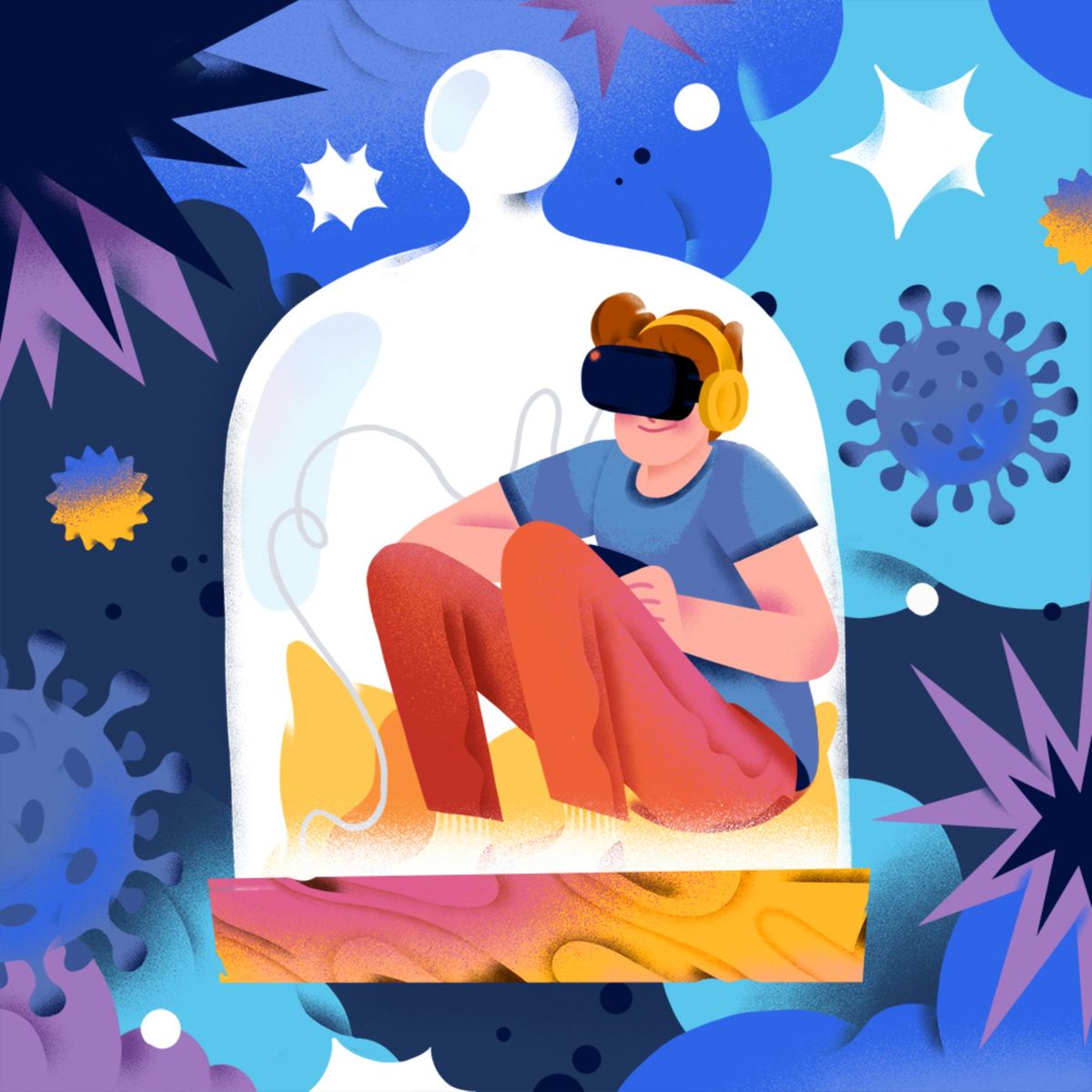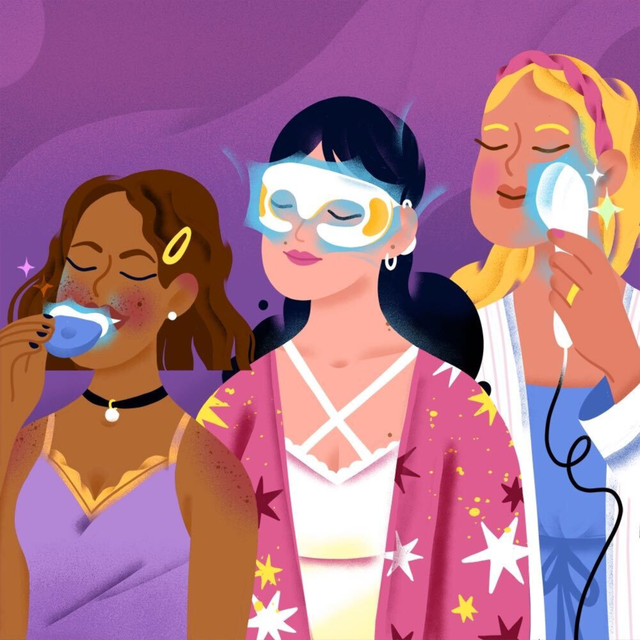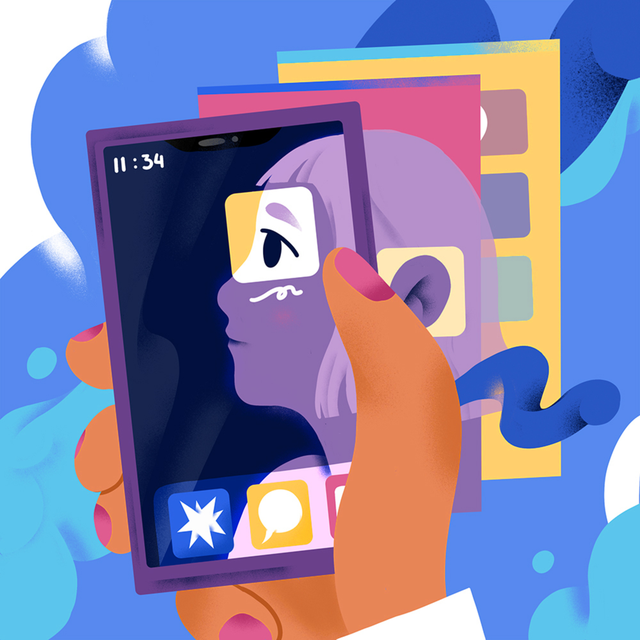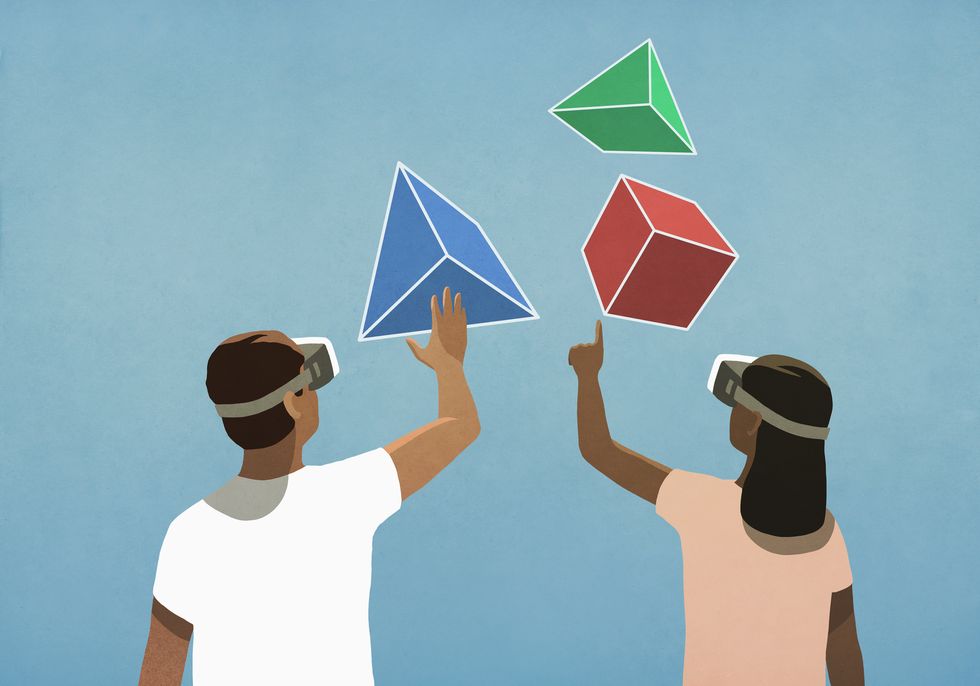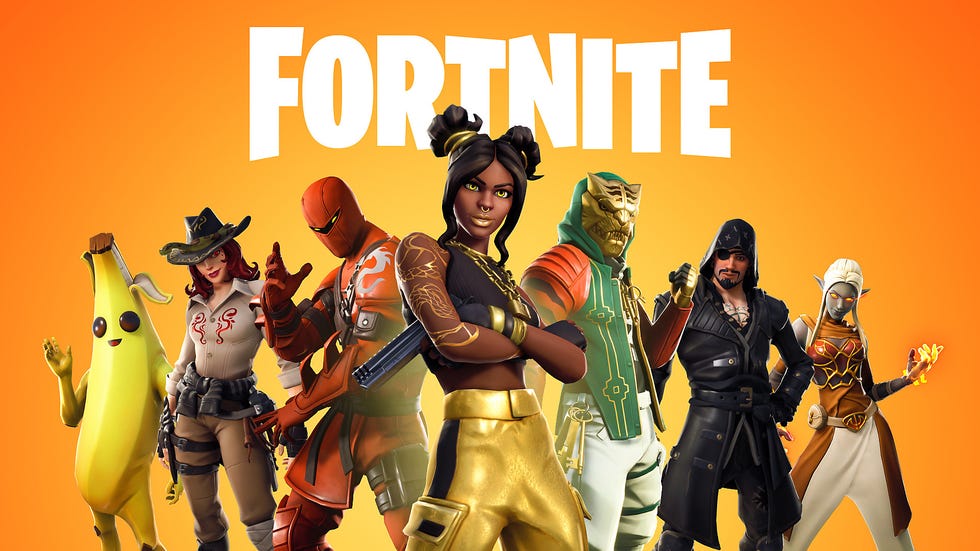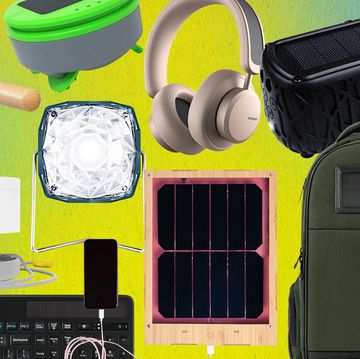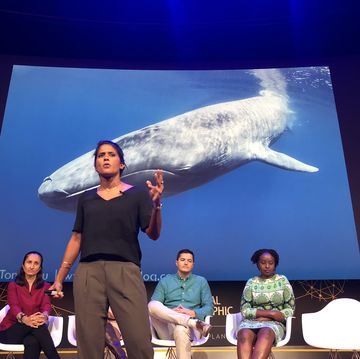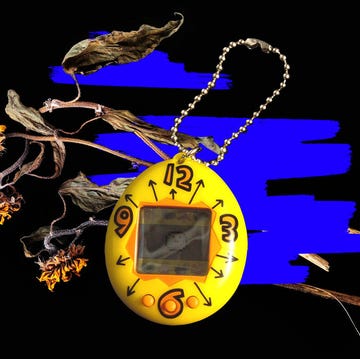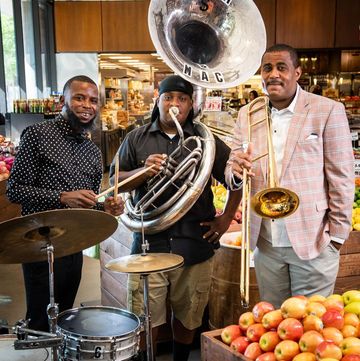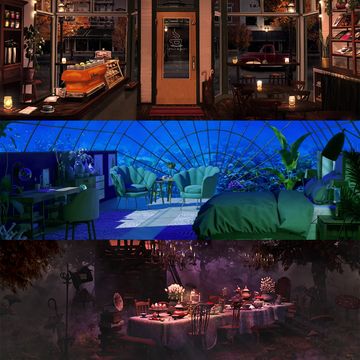When the U.S. screeched to a halt in March 2020 as a result of the pandemic, technology spared the world from a complete and total shutdown. From Zoom meetings to e-commerce to VR concerts, technology kept us connected and kept businesses running. We could continue taking workout classes via Instagram Live and Zoom, seeing our doctors face to face through video calls, and even hanging out together in virtual chat rooms. For those of us who live alone, it spared us from complete aloneness.
Given the reach technology has in every facet of our lives, and how central it’s been to our survival during Covid-19, Shondaland wanted to explore where tech is today, how we relate to it, where it’s headed, and the ways it will reshape our lives in the near future.
At the beginning of 2020, virtual reality concerts that viewers attended from their couches wearing bulky VR headsets were a fun novelty, but not at all mainstream. People would gather in cyberspace with others (or by themselves) to watch a show, and they felt like they were right there, completely immersed in a 360-degree experience.
The average person didn’t attend a VR concert — those were limited to VR enthusiasts. But then Covid-19 happened. With live concerts banned until further notice in the U.S., a slow rise in VR concerts have taken place.
Technology: A Shondaland Series
An uptick in virtual experiences since Covid-19 isn’t limited to VR headsets. Thanks to the pandemic, finding ways to virtually hang out with friends and acquaintances has become less about a fun pastime and more about staying meaningfully connected to others. But video calls and virtual happy hours can only go so far. No one wants to live out their entire social lives on Zoom.
Given the pandemic has changed the way we hang out with our friends during social distancing, virtual concerts and social video games are more appealing than ever before.
Can we experience the same level of intimacy and social interaction hanging out in a virtual space online as we do in a real-life one? No. But for the time being, capitalizing on these new ways to connect can help us better survive the duration of the pandemic without feeling completely disconnected.
Virtual reality vs. virtual experience
The difference between a virtual experience and virtual reality hinges on how immersive the experience is. VR requires a headset, and the technology is designed to trick your brain into thinking you’re in a completely different space. It’s like looking into those old Viewfinder toys with a wheel of pictures you click through, but instead of looking at a two-dimensional picture, VR understands your position and will show you what’s behind you when you look around with your head, as you would in real life.
A virtual experience or virtual event typically just refers to an online, digital experience. All those Zoom conferences, Instagram concerts, and remote exercise classes are good examples.
Using VR requires a hefty amount of computer power, and it’s only in the past decade that the personal computers and laptops have had enough power to support VR applications. Because the tiny screens inside headsets are so close to a person’s eyes, the headset must display high-resolution graphics, which demands a lot of memory. This need for a lot of memory is one reason VR hasn’t completely caught on with the mainstream.
But as mobile phones grew in computing power and popularity, Google developed a VR tool called Google Cardboard, where the whole VR setup consisted of a mobile phone for the computer and screen and a piece of cardboard folded into goggles to hold that phone. The idea here is getting more people to try VR and use VR apps so that more VR experiences have a sustainable audience size to grow.
Video games and the playable community
Though many video games incorporate VR, which is one major reason people are opting into the VR experience, meaningful social interaction in the video game space is still vibrant on 2D screens through traditional gaming consoles hooked up to our TVs, or games played on our laptops, desktops, or phones. Though they don’t create a 360-degree experience, these games are still powerful virtual worlds, in that they are big, three-dimensional worlds that you can roam, but you still interact with them on the 2D screens we’ve been using for years.
Here, people socialize through these games with voice or text chat. Friends set times to play together, or you can socialize with strangers who are playing at the same time you are. Going a step further, some games are trying to induce more opportunities for gatherings, even if you’re not actually playing the game.
The hugely popular, online, multiplayer first-person shooting game Fornite, in April, brought in musical artist and rapper Travis Scott for a worldwide concert. The game is a more animated and unrealistic version of a war game like Call Of Duty first-person shooter, but because of how all players are joining online to play together, it’s also very communal and has begun to leverage that community to host events for players to join.
In the case of Travis Scott’s Fortnite tour (a five-show run), Scott performed as an avatar and could go beyond the limitations of the physical stage show. Fans watched in the digital world and could use their own avatars to dance along.
Even if the video games don’t live in a headset that you’re strapping to your face, gaming can create a deep sense of community within what feels like a physical space. Even though the worlds Fortnite creates are technically and visually impressive, a game doesn’t even have to be super complex or technical to bring in emotional depth. Animal Crossing New Horizon on the Nintendo Switch is a perfect example of an overall simplistic game that has really helped fill the loneliness a pandemic can create head-on.
In the latest Animal Crossing game, each player lives on an island and does tasks to build it out for animal villagers that live there too. While fun on its own, the real appeal is that players can visit their friends’ islands and interact with each other in the game similar to how they might in person.
To overcome physical isolation, people began having birthday parties and weddings inside the game, on their island. This works by the host sending invite codes to their friends who (those with a Nintendo Switch and the Animal Crossing game) would enter the code to travel to that island. It works like an elaborate, visual, chat room. Guests can text with each other through the game and bring items from their own islands as gifts. Representative Alexandria Ocasio-Cortez even joined in on the fun and used the game to virtually visit different people’s islands during May at the height of physical isolation.
Creating an alternative identity
The use of avatars spans across most virtual environments from video games to concerts to VR as a way to give users a digital identity. These customized outfits and hairstyles may not be possible in the real world but can be shown off attending digital events.
Animal Crossing allows customization of most aspects of your player and once you reach a certain point in the game, a clothing store comes to your island and new clothes, hats, and accessories change are available on a daily basis. The game even began to include medical face masks as early as June in response to the pandemic.
Fortnite, too, revolves around its new seasonal skins (digital clothes) for players to wear. Fortnite is a completely free game to download and play but makes its money from in-game purchases of clothing or skins and avatar accessories. The boom around the game has really shown how much people value and love making their virtual character unique and reflective of some aspect of their personality.
There have been at least a few studies that show people like to customize their avatar or digital representation of themselves. According to research scientist Nick Yee, people create idealized versions of themselves to minimize physical flaws. People have also been shown to be more invested and favorable to their digital avatars depending on their self-confidence.
With conferences like Comic-Con on hold during COVID, dressing up as an avatar can act as a substitute for in-person cosplay. Finding a way to step out of reality and into the world of imagination and play can be a respite during these times when so many of us are confined to our couches at home, each day seems the same.
Virtual reality concerts
The future of VR concerts, those that require some sort of hardware so you have a 360-degree immersive experience, were poised to only grow gradually, mainly because the gear needed to attend is somewhat of a barrier to entry. A good VR headset isn’t cheap — the average cost of an Oculus headset, one of the most popular on the market, costs around $400.
Plus, VR concerts often require complex camera systems on the performer’s side too to capture all their movements from all angles.
Now that the concert industry has found itself completely devastated in the first half of 2020, demand for VR concerts and live video broadcasts has emerged.
During its August 5 earnings call, one of the largest event companies, Live Nation reported a 98% drop in revenue compared to the same quarter a year ago due to COVID-19 shutting down live concerts. The company indicated during the same call that it was hopeful that live concerts will return in force in 2021, stating that the majority of ticket holders are holding on to their purchases, waiting for rescheduled shows, instead of requesting refunds.
Live Nation CEO Michael Rapino said that 67 million fans used its platform for streaming around 18,000 concerts or festivals globally. As a way to pivot to online and VR concerts more quickly, without needing people to have a headset, the performers are going 3D, but the show is viewable on any screen, not just in a VR headset.
The Canadian singer/songwriter The Weeknd, for example, partnered with TikTok and Wave, a VR music platform, to bring a special concert event to fans around the world. Using Wave’s technology and equipment The Weeknd transformed into a digital avatar and broadcast his performance on TikTok’s app. Viewers are seeing him perform as would be the case with live video, but all of his movements are being captured so the camera views can be from any angle with any type of fantastical backgrounds and views. (You can now go back and watch recorded songs from the show to see what it was like for live viewers.)
During the live show on Friday, August 7, it achieved 1.2 million total unique views.
The event saw a peak of 275,000 concurrent viewers. This may seem like a fraction of the total viewership, but compared against a stadium show from The Weeknd’s 2017 Starboy Tour, it’s astronomical. In late 2017, the Nashville show at Bridgestone Arena sold out with just over 15,000 attendees.
“By combining our technology with The Weeknd team’s creativity, we've created a truly unique, interactive experience that demonstrates the huge potential of this new medium,” said Adam Arrigo, CEO of WaveVR. “TikTok served as the perfect platform to host this virtual event, as it is home for the next generation of concert-goers - young passionate music lovers.”
Virtual communities beyond concerts and games
Outside video games or live events, lots of new online experiences have begun to crop up that signals these digital communities could blossom beyond quarantine experimentations.
Facebook has been one of the leaders pushing its general virtual reality spaces, which could be a natural evolution of its Groups feature. Facebook bought VR company Oculus in 2014 preparing for a time when more of our time would be spent fully immersed in 3D worlds.
Facebook Horizon, formerly called Facebook Spaces, is one of its VR apps that lets you play chess, share photos, or just sit with friends in a virtual world.
Facebook, through Oculus, continues to invest in the emotional elements of VR like translating hand gestures across the whole body. The latest consumer version of its hardware, Oculus Quest includes hand-tracking controllers to allow more natural interactions in a digital space. This hand tracking is translated into facial expressions for certain contexts. For example if your avatar gives a thumbs up, it also smiles too. If a thumbs down, the virtual face frowns.
Virtual reality as a way we continue to further our relationship with technology is a near certainty. It facilitates our desire for human connection without leaving our home, but it’s not the only way technology is helping us.
“Playing in a VR world while talking to someone feels similar to the fidget activities you can do while you're on a phone call,” said Danielle Baskin, founder of Dialup. “But VR can be very awkward, especially if you're in a public chat room. I tried VR Chat and had difficulty interacting. I'm social in reality, but it was really difficult to approach people in VR (maybe because my avatar was a giant milk carton). I did witness some heart-to-heart conversations, so I totally think there's a possibility for intimate connections through VR. But there's a learning curve. People might not engage with you if you're stumbling around or if you don't have a cool avatar. It takes a lot of time to become ‘good’ at being in VR. Right now, it's hard to just casually hang out or meet people. And it's unlikely that your friends have a headset.”
Dialup is an app that lets two people from anywhere in the world connect over a shared interest for a voice call. In this regard it allows people to dip into a virtual community in a more analog way. The idea is like calling up a party telephone number that had popularity during the 1990s but in a modern way.
“It's not a massive group chat like Discord, but rather, we connect people with shared interests into random pairs for voice conversations. So it feels like attending a party where you end up chatting to whoever happens to be standing next to you,” said Baskin. “Even if people sort of know each other, or they just met, a voice call can make you feel a lot closer. And these close connections at scale is what gives Dialup its community feeling. Our community is a cluster of strong ties between pairs.”
While the social isolation in 2020 has helped more people see how full-on virtual reality events and gatherings can become more common, it’s really the connection that VR and these games offer that most people are craving at the moment.
New online communities and activities are providing a way to connect at a time when happy hour after work isn’t really possible. COVID-19 is pushing us towards technologies that can bring us closer virtually because what we really want is to connect better in any way possible. And standard Zoom meetings aint it.
What is becoming more clear is that a lot of these new ways we can socialize and connect digitally are already present. The biggest change is that we’re more aware of how we want our digital spaces to help us prioritize socialization and how they can do that in a safe and fun way.
Tyler Hayes is an early adopter and technology writer based in California who’s contributed to Fast Company, BuzzFeed, and Billboard, among others.
Get Shondaland directly in your inbox: SUBSCRIBE TODAY
